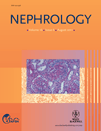Urinary transforming growth factor-β1 in children with obstructive uropathy
ABSTRACT:
Aim: Obstructive uropathies (OU) in childhood constitute one of the major causes of chronic renal insufficiency. Transforming growth factor-β1 (TGF-β1) is considered to be the major fibrogenic growth factor. The aim of the present study was to investigate urinary TGF-β1 levels in children with obstructive and non-obstructive uropathies (NOU).
Methods: This study involved 19 children with OU, 11 children with non-obstructive hydronephrosis and 21 healthy children. Urinary TGF-β1, proteinuria, microalbuminuria and urinary α1-microglobulin were measured, and renal function was assesed. The results were statistically analyzed.
Results: Mean urinary TGF-β1 concentrations in patients with OU were significantly higher than those with NOU (4.14 ± 0.67 creatinine vs 1.80 ± 0.24 pg/mmol creatinine, P < 0.05) and healthy controls (1.66 ± 0.28 pg/mmol creatinine, P < 0.05). Positive correlations of urinary TGF-β1 concentrations with proteinuria (r = 0.87, P < 0.0001) and urinary α1-microglobulin (r = 0.82, P = 0.0002) were found in patients with OU.
Conclusion: Children with OU have higher urinary TGF-β1 than children with NOU. Urinary TGF-β1 may be a useful non-invasive tool for the differential diagnosis between OU and NOU in children. A positive correlation of TGF-β1 with markers of renal tissue damage in patients with OU was found.




